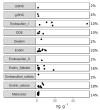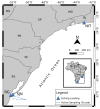Persistent Organic Pollutants (POPs) in Sardine (Sardinella brasiliensis): Biomonitoring and Potential Human Health Effects
- PMID: 36767402
- PMCID: PMC9916167
- DOI: 10.3390/ijerph20032036
Persistent Organic Pollutants (POPs) in Sardine (Sardinella brasiliensis): Biomonitoring and Potential Human Health Effects
Abstract
Organochloride (OC) and polychlorinated biphenyl (PCB) concentrations were determined in the muscle tissue of fifty sardine samples (Sardinella brasiliensis) sampled off the south-east Brazilian shelf. The aim herein was to investigate OCs and PCBs composition profile, bioaccumulation potential and human risks. The concentrations of 18 organochlorine pesticides (OCPs) were below the method limit of quantification in most samples (ca. 94%), with few detected, namely δ-HCH, γ-HCH, Endosulfan I and II, Endosulfan Sulphate, DDE, Dieldrin, Endrin, Endrin Aldeide, Endrin Cetone and Metoxyclor. The median concentration for the Σ41 PCBs was 2.32 ng g-1, ranging from values below the limit of quantification (<LOQ) to 37.2 ng g-1. Based on the analyzed samples, the concentrations reported herein do not represent a risk for human consumption according to both national and international guidelines, nor do OC and PCB bioaccumulation in sardines appear to be a concern at the moment. These findings, although preliminary, represent a baseline for future comparisons of the quality of an important source of protein available to the poorest Brazilian population strata.
Keywords: PCBs; POPs; fish consumption; human risk.
Conflict of interest statement
The authors declare that they have no known competing financial interest or personal relationships that could have appeared to influence the work reported in this paper.
Figures





Similar articles
-
Persistent organic pollutants in fish: biomonitoring and cocktail effect with implications for food safety.Food Addit Contam Part A Chem Anal Control Expo Risk Assess. 2019 Apr;36(4):601-611. doi: 10.1080/19440049.2019.1579926. Epub 2019 Mar 12. Food Addit Contam Part A Chem Anal Control Expo Risk Assess. 2019. PMID: 30862267
-
Distribution of OCPs and PCBs in Mussels (Mytilus galloprovincialis) from the Marmara Sea Coastal Sites.Bull Environ Contam Toxicol. 2016 Aug;97(2):191-7. doi: 10.1007/s00128-016-1848-x. Epub 2016 Jun 21. Bull Environ Contam Toxicol. 2016. PMID: 27329111
-
Legacy persistent organic pollutants (POPs) in archive samples of wild Bluefin tuna from the Mediterranean Sea.Mar Pollut Bull. 2020 Jun;155:111086. doi: 10.1016/j.marpolbul.2020.111086. Epub 2020 May 1. Mar Pollut Bull. 2020. PMID: 32469755
-
A review of organochlorine pesticides and polychlorinated biphenyls in Lebanon: Environmental and human contaminants.Chemosphere. 2019 Sep;231:357-368. doi: 10.1016/j.chemosphere.2019.05.109. Epub 2019 May 15. Chemosphere. 2019. PMID: 31136903 Review.
-
Organochlorine residues and elemental contaminants in U.S. freshwater fish, 1976-1986: National Contaminant Biomonitoring Program.Rev Environ Contam Toxicol. 1999;162:43-104. doi: 10.1007/978-1-4612-1528-8_2. Rev Environ Contam Toxicol. 1999. PMID: 10392042 Review.
Cited by
-
Trophic Chain Organochlorine Pesticide Contamination in a Highly Productive Upwelling Area in Southeastern Brazil.Int J Environ Res Public Health. 2023 Jul 11;20(14):6343. doi: 10.3390/ijerph20146343. Int J Environ Res Public Health. 2023. PMID: 37510576 Free PMC article.
References
-
- Panseri S., Chiesa L., Ghisleni G., Marano G., Boracchi P., Ranghieri V., Malandra R.M., Roccabianca P., Tecilla M. Persistent organic pollutants in fish: Biomonitoring and cocktail effect with implications for food safety. Food Addit. Contam. Part A. 2019;36:601–611. doi: 10.1080/19440049.2019.1579926. - DOI - PubMed
-
- Iordache A., Iordache M., Sandru C., Voica C., Stegarus D., Zgavarogea R., Ionete R.E., Cotorcea S., Miricioiu M.G. A fugacity based model for the assessment of pollutant dynamic evolution of VOCs and BTEX in the Olt River basin (Romania) Rev. Chim. 2019;70:3456–3463. doi: 10.37358/RC.19.10.7575. - DOI
Publication types
MeSH terms
Substances
LinkOut - more resources
Full Text Sources
Medical

